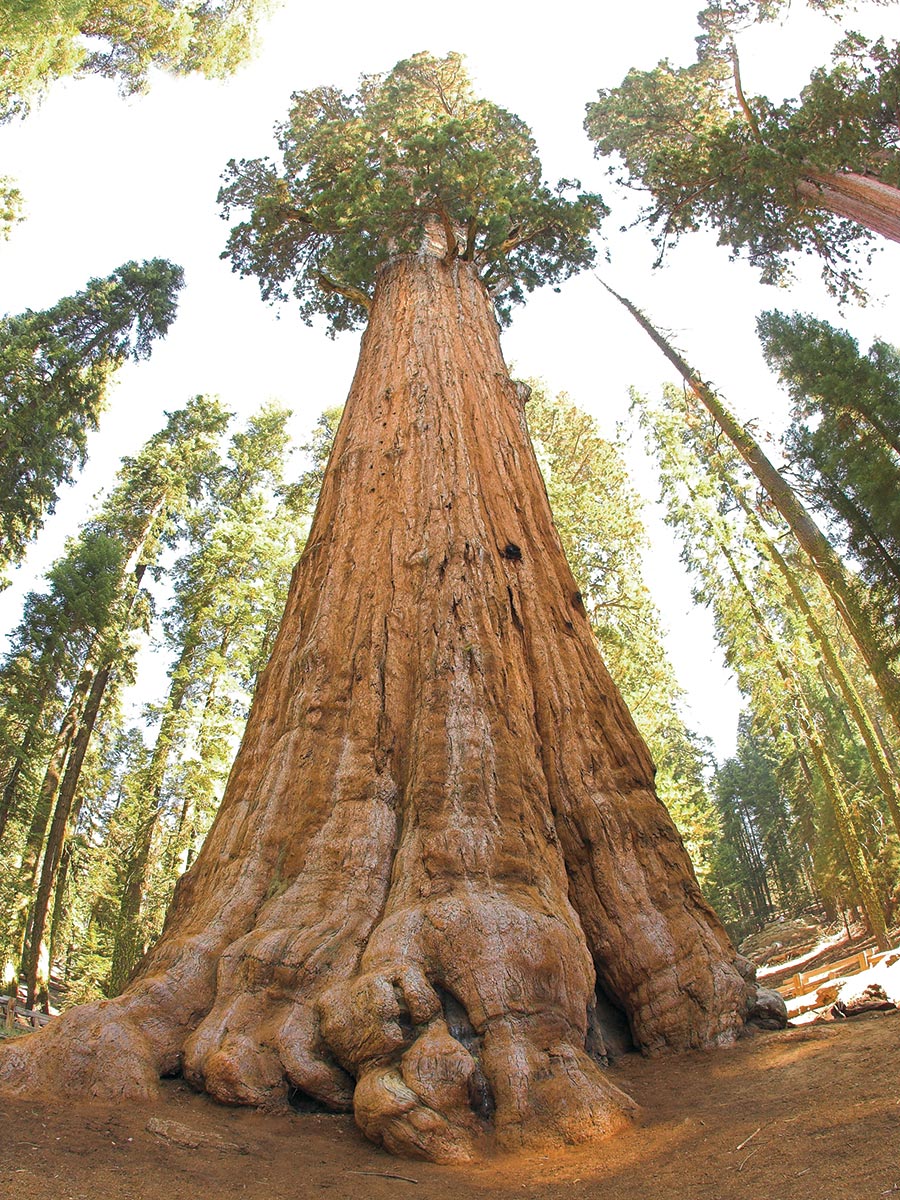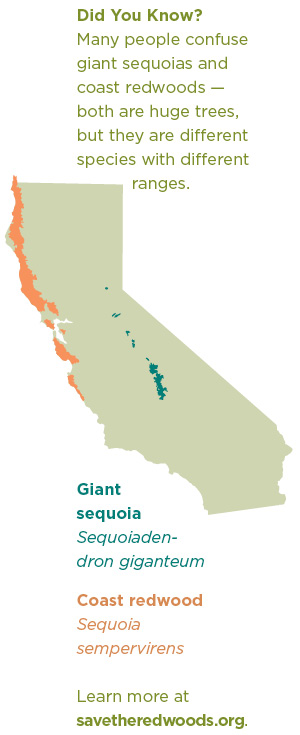Giants Among Us

Looking up at the General Sherman Tree. PHOTO Jim Bahn/Wikimedia Commons (CC by 2.0)
When descending down the paved path toward the largest tree on the planet, a giant sequoia named General Sherman, most visitors begin in a parking lot, on a hill above the height of its tallest branches. Their first glimpses of the enormous tree, then, are of its top. It’s an interesting perspective, but it isn’t until arriving at the bottom that the sequoia’s true immensity takes shape — its 36-foot-wide trunk revealed through the neighboring trees like a cruise ship peeking around a seaside cliff. General Sherman makes trees that would otherwise seem huge look like twigs. Necks crane. Jaws drop. Selfie sticks come out.
Sequoia National Park in California is the second oldest national park in the U.S., and over a million people travel there every year to see what are, quite simply, famous plants. That is unusual. The General Sherman Tree and its sequoia companions in the surrounding woods are not humpback whales leaping from the ocean, giant geysers exploding from the earth, or bears catching salmon in their jaws. Giant sequoias (Sequoiadendron giganteum) are less action and more quiet awe. Yet the tour buses pour in and thankfully so. Plants deserve their time in the spotlight too.
At around 2,200 years old, General Sherman is not the oldest tree in the world (it is actually middle-aged for a sequoia). Nor is it the tallest at a height of 275 feet (about 25 stories). It is, however, the most massive tree in the world by volume (it could hold about 10,000 bathtubs worth of water). It is truly humbling to stand before such a being. “These trees destroy the passive image we have of plants; the simple word ‘tree’ cannot convey their authority, cannot communicate their dignified bulk,” wrote author Stephen Trimble in 1979.
Giant sequoias are less action and more quiet awe.
 Sequoias are found naturally only on the western slope of the Sierra Nevada in a relatively tight band between 5,000- and 8,000-feet elevation. Around them grow other impressively large trees, such as sugar pines (Pinus lambertiana) and incense cedar (Calocedrus decurrens). At full heights of around 220 feet, these scrape the heavens too, but the giants still command the space.
Sequoias are found naturally only on the western slope of the Sierra Nevada in a relatively tight band between 5,000- and 8,000-feet elevation. Around them grow other impressively large trees, such as sugar pines (Pinus lambertiana) and incense cedar (Calocedrus decurrens). At full heights of around 220 feet, these scrape the heavens too, but the giants still command the space.
If visiting, don’t just stop at General Sherman with the rest of the hordes. Pay your respects (and maybe stand in line for the perfect selfie), but then go gently deeper into the Giant Forest along the park’s soft, quiet paths made buoyant by built-up layers of tree duff.
There you can encounter four more of the 10 largest sequoias in the world among extensive sequoia groves. And while the General Sherman Tree is protected from trampling and pawing by a low split-rail fence, the sequoias in the rest of the Giant Forest stand naked before you. You can pet the spongy bark that insulates them from fire and wander among their enormous trunks like a child playing among the furry legs of Mr. Snuffleupagus. Marvel at the realization that they are growing in soil only 3 to 5 feet deep — their roots sprawling across the forest in an interconnected tangle, a community of trees lending each other support and stability.
Those titanic sequoias have experienced countless fires, droughts, freezing summers and warmer-than-usual winters. They have gulped millions of gallons of water, only to be exhaled as the oxygen that we inhale to survive. They have racked up thousands of years on the western slope of the Sierras, growing from seed to behemoth as human cultures have risen and fallen across the earth. Here’s hoping that they can survive the challenges we throw at them today.
To sit in a grove of giant sequoias is to connect to the deep well of time — to sense the brevity of one’s own life against the long unfurling of millennia. Sighs of relief and a gentle release from daily worries seem to come easy. Among the giants, it feels like contentment

